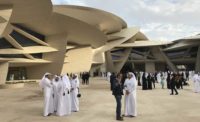Zurich
The longtime home of the Swiss National Museum, or Landesmuseum, in Zurich, is a stolid 19th-century pile. Its central courtyard opens onto a leafy park overlooking the Limmat River. But if the building’s C-shape allowed it to embrace the landscape behind it, it also meant that circulation routes from the main lobby—to the east and west—led to dead ends.
Commissioned to expand the old museum, designed by Gustav Gull, and completed in 1898, Basel-based architecture firm Christ & Gantenbein had to solve one problem, the dead ends, without creating another: cutting off the park. The architects did so by adding a zigzag connector that completes the circuit begun by the C while rising like a giant chevron to provide park access and views. The triangular tunnel created by the chevron is nearly 100 feet across at grade. It is one of several bold moves employed by Emanuel Christ and Christoph Gantenbein—both of whom are teaching at Harvard’s Graduate School of Design this fall—in their quest to update what is said to be the most visited cultural-history museum in Switzerland.
The original museum building, directly across from Zurich’s main railway station, is a masonry hodgepodge with too many towers and turrets, suggesting a cross between a hunting lodge and Cinderella’s castle. Christ and Gantenbein’s 80,000-square-foot addition doesn’t replicate the turrets, but it does echo their acute angles in its switchbacks. Still, the shape of the addition is no mere homage. It evolved from efforts to preserve as much of the park as possible, and even to protect specific trees, says Christ.
While addressing those constraints, “the building attempts to find a certain autonomy as a sculptural object,” continues Christ, who calls the approach “expressive contextualism.”
The original building’s adorned surfaces were meant as a showcase for Swiss decorative arts. Christ and Gantenbein, on the other hand, clad their addition entirely in board-formed concrete. That includes even emergency exits, which are practically invisible from the outside. Roofs are covered in corrugated fiber cement. So determined were they to keep from breaking the lines of their sharply angled composition that all mechanicals are hidden. The loading dock, inventively, is a contraption that rises up into a parking lot, never touching the aboveground portion of the building. The only openings in the addition are the porthole windows, which echo the rows of arched fenestration in the old building and, in many cases, provide tantalizing glimpses of Gull’s confection, as if concentrated bits of it were inset into Christ & Gantenbein’s thick concrete walls.
Inside, a dramatic stairway set into one side of the chevron rises 30 feet to the second-floor galleries. Interior walls are the same gray concrete, and floors are a buff-colored terrazzo. That’s a tough combination even for lovers of spare architecture. But for visual stimulation, one need only look up at the ceilings, where metal raceways containing lighting and ductwork angle through the spaces, suggesting a vast Louise Nevelson sculpture.
For Christ and Gantenbein, the museum commission came 14 years ago, when, just a few years out of architecture school at the ETH Zurich, they won a competition to renovate and enlarge the museum. The renovation work, which began in 2006, created a brilliant mix of old and new. (Controversy over funding caused the addition to be delayed.) Gull’s ornament is leavened by Christ & Gantenbein’s restrained interventions, including light fixtures that recall the work of minimalist artist Dan Flavin, and new concrete vaults and columns placed alongside Gull’s stucco and stone.
The scale of the exhibition halls—cavernous spaces that are not discrete galleries but parts of a continuous circulation route—requires that the exhibition designers create freestanding showcases and “islands” of objects; most items would be lost if simply hung on, or placed against, the walls.
The rooms seem to work best for ancient artifacts such as a large Roman bust or column capital, which are themselves monochromatic. (The museum represents the history of Switzerland from its origins to the present day.) Artworks with bright hues—like a Renaissance fresco by the Florentine artist Andrea del Castagno that hangs over a porthole—seem practically garish against the all-gray background. The exhibition designers have worked to insert color, with a lavender wall backing one exhibition and a magenta partition cutting through another. The sections of the new building not devoted to showcasing art, which include administrative offices, an auditorium, and a research library, are relatively colorless.
This is a big year for Christ and Gantenbein, who have also unveiled an addition to the Kunstmuseum Basel for contemporary art. There they used heavily veined marble and galvanized metal to variegate the interior and exterior walls. But in Zurich, it is geometry rather than surface treatment that gives their architecture its power.
PeopleArchitect: Christ & Gantenbein
Personnel in architect's firm who should receive special credit: Emanuel Christ
Engineers Structural engineering:
Consultants Landscaping:
General contractor: Christ & Gantenbein and Proplaning, Basel
Photographer: Iwan Baan
|
|

















